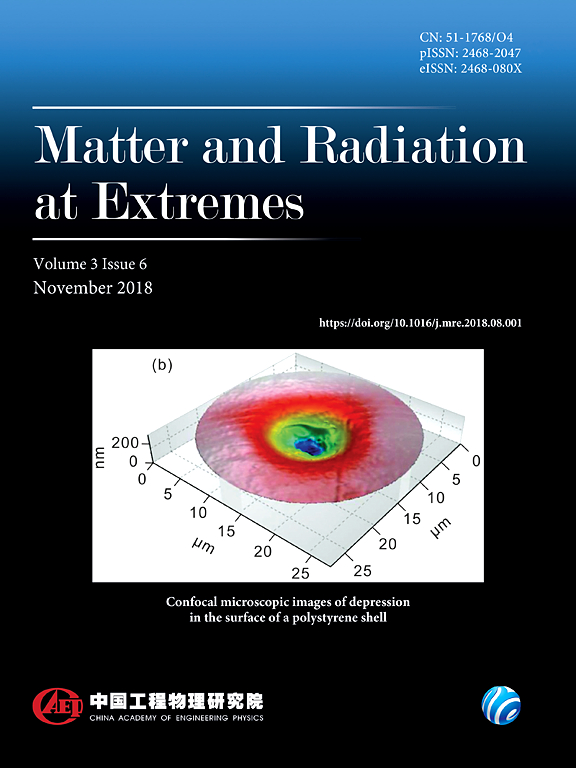Fundamental influence of irreversible stress–strain properties in solids on the validity of the ramp loading method
IF 4.7
1区 物理与天体物理
Q1 PHYSICS, MULTIDISCIPLINARY
引用次数: 0
Abstract
The widely used quasi-isentropic ramp loading technique relies heavily on back-calculation methods that convert the measured free-surface velocity profiles to the stress–density states inside the compressed sample. Existing back-calculation methods are based on one-dimensional isentropic hydrodynamic equations, which assume a well-defined functional relationship P(ρ) between the longitudinal stress and density throughout the entire flow field. However, this kind of idealized stress–density relation does not hold in general, because of the complexities introduced by structural phase transitions and/or elastic–plastic response. How and to what extent these standard back-calculation methods may be affected by such inherent complexities is still an unsettled question. Here, we present a close examination using large-scale molecular dynamics (MD) simulations that include the detailed physics of the irreversibly compressed solid samples. We back-calculate the stress–density relation from the MD-simulated rear surface velocity profiles and compare it directly against the stress–density trajectories measured from the MD simulation itself. Deviations exist in the cases studied here, and these turn out to be related to the irreversibility between compression and release. Rarefaction and compression waves are observed to propagate with different sound velocities in some parts of the flow field, violating the basic assumption of isentropic hydrodynamic models and thus leading to systematic back-calculation errors. In particular, the step-like feature of the P(ρ) curve corresponding to phase transition may be completely missed owing to these errors. This kind of mismatch between inherent properties of matter and the basic assumptions of isentropic hydrodynamics has a fundamental influence on how the ramp loading method can be applied.固体不可逆应力应变特性对斜坡加载法有效性的基本影响
广泛使用的准各向同性斜坡加载技术在很大程度上依赖于反向计算方法,该方法可将测得的自由表面速度曲线转换为压缩样品内部的应力密度状态。现有的反向计算方法基于一维各向同性流体力学方程,该方程假定整个流场的纵向应力和密度之间存在定义明确的函数关系 P(ρ)。然而,由于结构相变和/或弹塑性响应带来的复杂性,这种理想化的应力-密度关系一般并不成立。这些标准的反向计算方法如何以及在多大程度上会受到这种内在复杂性的影响,仍然是一个悬而未决的问题。在此,我们利用大规模分子动力学(MD)模拟进行了仔细研究,其中包括不可逆压缩固体样品的详细物理过程。我们根据 MD 模拟的后表面速度曲线反向计算应力密度关系,并将其与 MD 模拟本身测得的应力密度轨迹进行直接比较。在本文研究的案例中存在偏差,这些偏差与压缩和释放之间的不可逆性有关。在流场的某些部分,可以观察到稀释波和压缩波以不同的声速传播,这违反了等熵流体力学模型的基本假设,从而导致了系统性的反向计算误差。特别是,由于这些误差,P(ρ) 曲线上与相变相对应的阶梯状特征可能会被完全忽略。物质的固有特性与等熵流体力学基本假设之间的这种不匹配,对如何应用斜坡加载法产生了根本性的影响。
本文章由计算机程序翻译,如有差异,请以英文原文为准。
求助全文
约1分钟内获得全文
求助全文
来源期刊

Matter and Radiation at Extremes
Physics and Astronomy-Atomic and Molecular Physics, and Optics
CiteScore
8.60
自引率
9.80%
发文量
160
审稿时长
15 weeks
期刊介绍:
Matter and Radiation at Extremes (MRE), is committed to the publication of original and impactful research and review papers that address extreme states of matter and radiation, and the associated science and technology that are employed to produce and diagnose these conditions in the laboratory. Drivers, targets and diagnostics are included along with related numerical simulation and computational methods. It aims to provide a peer-reviewed platform for the international physics community and promote worldwide dissemination of the latest and impactful research in related fields.
 求助内容:
求助内容: 应助结果提醒方式:
应助结果提醒方式:


